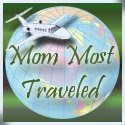I am still in the process of ridding our cabinets of cups, bottles, and plates that contain the harmful hormone-disrupting chemicals. It requires a lot of research to determine what things are safe and what aren't. Beyond plates and cutlery, what about the containers in which some foods are sold? What about plastic toys?
I am trying to educate myself about the plastics labels. Not only is it hard to remember what each plastic number means, some of them are not even labeled!
I was also surprised to learn that a recycling symbol on the bottom of a bottle does not necessarily mean that the product is recyclable.
The labels to avoid are 3, 6, and 7: The products labeled with "3" contain Polyvinyl Chloride, or PVC. PVC is not accepted by most recycling programs, although it is possible to recycle PVC into building material. PVC has been found to pose dangers to human health as well as to the environment. PVC has hazardous qualities in the factories where it is produced and in our homes.
The products labeled with "3" contain Polyvinyl Chloride, or PVC. PVC is not accepted by most recycling programs, although it is possible to recycle PVC into building material. PVC has been found to pose dangers to human health as well as to the environment. PVC has hazardous qualities in the factories where it is produced and in our homes.
Those who work with Vinyl Chloride have a high risk of liver cancer, lung cancer, brain cancer, lymphoma, and leukemia. When PVC is made (or burned), harmful chemicals called "dioxins" are released. These chemicals can cause suppressed immune function and harm the reproductive system by disrupting hormones. They are also carcinogenic. Even low level exposures can cause low birth weight, and learning and behavior problems in children.
PVC needs many additives to make it stable and usable. Often these
chemical additives are harmful in and of themselves. Lead is often added to strengthen PVC. Another common additive is DEHP. DEHP is a phthalate suspected of causing cancer and reproductive disruption. Children are exposed to phthalates in PVC when they chew on vinyl toys. In 2005, European Parliment voted to ban the use of toxic phthlates in toys. They are still legal for use by US toy companies. Soft PVC (like those used in baby toys) contains plasticizers, usually phthalate esters,which are not chemically bound to the plastic and therefore leach or migrate. Phthalates in soft PVC toys have been banned in Austria, Denmark, Sweden, Norway, Greece and Mexico.
You know that "plastic smell", like the kind that emanates from a new car or a shower curtain? that is poisonous chemicals "off-gassing" from the PVC. According to the Center of Health, Environment, and Justice, "One EPA study found that vinyl shower curtains can cause elevated levels of dangerous air toxins, which can persist more than a month."
How can we spot harmful PVC toys? Healthy Child, Healthy World answers, "Some PVC toys may be labeled with a V or #3 inside the chasing arrows triangle usually located on the bottom of a product. Most won't be labeled at all. Generally, if a toy is a squishy plastic—like rubber duckies and baby dolls—or if it has highly flexible plastic as a component—like the clear pages in child "photo albums," the clear plastic purses that some girl's toys are sold in, or the plastic-like "fabric" used on some dolls—you should avoid it or call the manufacturer to ask if the product is made with PVC or phthalates."
Thursday, April 3, 2008
Dangers of #3 Plastics: PVC
Subscribe to:
Post Comments (Atom)


No comments:
Post a Comment